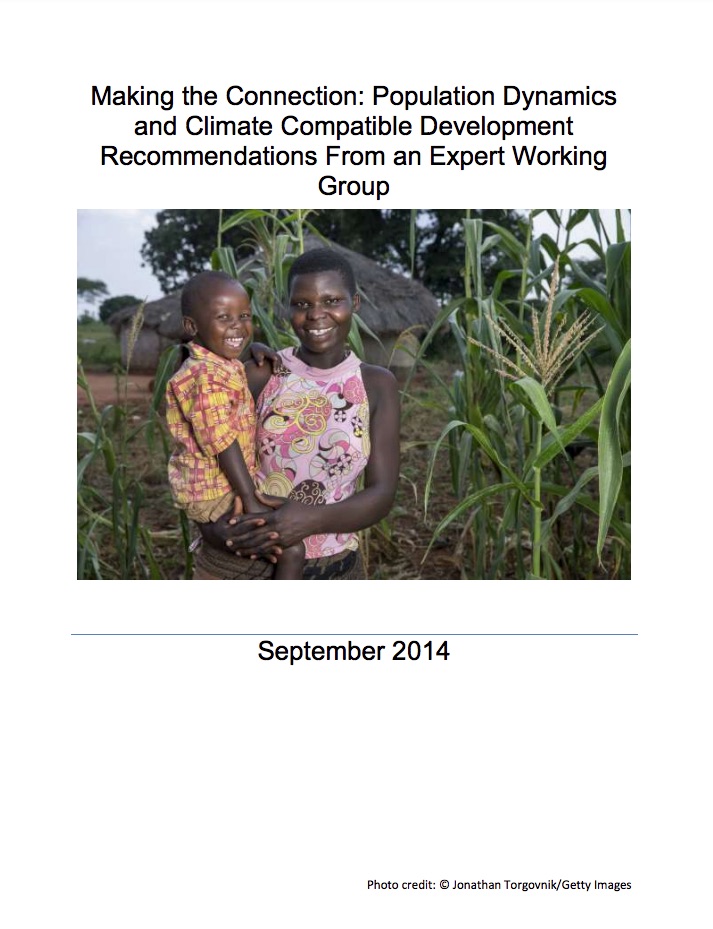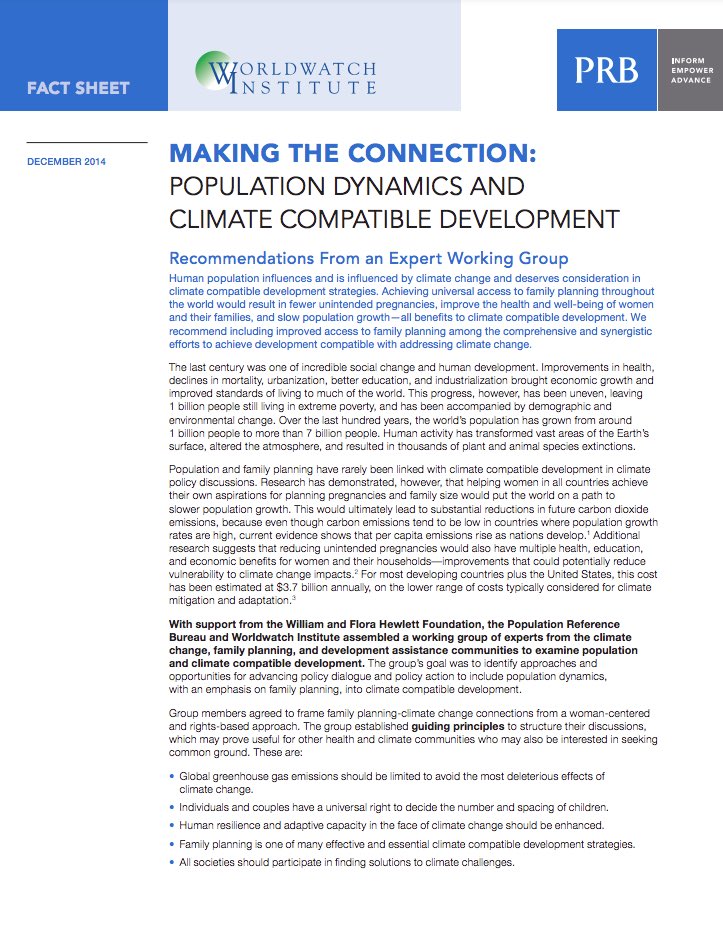
Making the Connection: Population Dynamics and Climate Compatible Development
Product: Report, Fact Sheets
Author: Kristen P. Patterson
Date: December 1, 2014
Human population influences and is influenced by climate change and deserves consideration in climate compatible development strategies. Achieving universal access to family planning throughout the world would result in fewer unintended pregnancies, improve the health and well-being of women and their families, and slow population growth—all benefits to climate compatible development. We recommend including improved access to family planning among the comprehensive and synergistic efforts to achieve development compatible with addressing climate change.
The last century was one of incredible social change and human development. Improvements in health, declines in mortality, urbanization, better education, and industrialization brought economic growth and improved standards of living to much of the world. This progress, however, has been uneven, leaving 1 billion people still living in extreme poverty, and has been accompanied by demographic and environmental change. Over the last hundred years, the world’s population has grown from around 1 billion people to more than 7 billion people. Human activity has transformed vast areas of the Earth’s surface, altered the atmosphere, and resulted in thousands of plant and animal species extinctions.
Population and family planning have rarely been linked with climate compatible development in climate policy discussions. Research has demonstrated, however, that helping women in all countries achieve their own aspirations for planning pregnancies and family size would put the world on a path to
slower population growth. This would ultimately lead to substantial reductions in future carbon dioxide emissions, because even though carbon emissions tend to be low in countries where population growth rates are high, current evidence shows that per capita emissions rise as nations develop.1 Additional research suggests that reducing unintended pregnancies would also have multiple health, education, and economic benefits for women and their households—improvements that could potentially reduce vulnerability to climate change impacts.2 For most developing countries plus the United States, this cost has been estimated at $3.7 billion annually, on the lower range of costs typically considered for climate mitigation and adaptation.3
With support from the William and Flora Hewlett Foundation, the Population Reference Bureau and Worldwatch Institute assembled a working group of experts from the climate change, family planning, and development assistance communities to examine population and climate compatible development. The group’s goal was to identify approaches and opportunities for advancing policy dialogue and policy action to include population dynamics, with an emphasis on family planning, into climate compatible development.
Group members agreed to frame family planning-climate change connections from a woman-centered and rights-based approach. The group established guiding principles to structure their discussions, which may prove useful for other health and climate communities who may also be interested in seeking common ground. These are:
- Global greenhouse gas emissions should be limited to avoid the most deleterious effects of climate change.
- Individuals and couples have a universal right to decide the number and spacing of children.
- Human resilience and adaptive capacity in the face of climate change should be enhanced.
- Family planning is one of many effective and essential climate compatible development strategies.
- All societies should participate in finding solutions to climate challenges.
- All societies should be enabled to pursue development pathways that simultaneously promote human well-being and limit climate change.
- Local participation in climate compatible development is important.
- Special needs and circumstances of particularly vulnerable populations should be considered.
The expert working group identified action opportunities to advance the goal of achieving universal access to family planning as part of climate compatible development, under four strategic approaches:
- Build awareness about trends in unintended pregnancy and unmet need for family planning, and their connections to climate change.
- Create an enabling environment for connecting these issues and advancing these policy opportunities by fostering more cross-sector dialogue and action among health, family planning, climate, and development sectors.
- Identify and act on policy opportunities to ensure that universal access to family planning is part of climate compatible development strategies.
- Increase the financing available for both climate change and family planning and create innovative financing for family planning within climate compatible development plans.
The specific action opportunities under each strategic approach provide a path forward for groups that want to link these issues and ensure that universal access to family planning is part of efforts to achieve climate compatible development.
When safe and effective family planning services are available to all, experience shows that average family size falls, pregnancies occur at more optimal times in women’s lives, and mothers and children are healthier and more able to contribute to their countries’ development—and are more resilient to rapid change.
Linking population, reproductive health, and climate change is unconventional for many policymakers. We urge openness to including universal access to voluntary family planning in climate compatible development plans. Cross-sectoral alliances and initiatives that highlight and integrate potential synergies
in development plans and in climate finance programs could reap enormous benefits, especially over time, for individuals and societies as we tackle climate change.
References
- Brian C. O’Neill et al., “Global Demographic Trends and Future Carbon Emissions,” Proceedings of the National Academies of Sciences 107, no. 41 (2010): 17521-26; and David Wheeler and Dan Hammer, “The Economics of Population Policy for Carbon Emissions Reduction in Developing Countries,” Working Paper 229 (Washington, DC: Center for Global Development, 2010).
- Karen Hardee and Clive Mutunga, “Strengthening the Link Between Climate Change Adaptation and National Development Plans: Lessons From the Case of Population in National Adaptation Programmes of Action (NAPAs),” Mitigation and Adaptation Strategies for Global Change 15, no. 2 (2010): 113-26.
- Scott Moreland, Ellen Smith, and Suneeta Sharma, World Population Prospects and Unmet Need for Family Planning (Washington, DC: Futures Group, 2010); estimation includes 99 developing countries with populations over 1 million (except China) plus the United States.
- Expert working group members: Suruchi Bhadwal, Leo Bryant, Keya Chatterjee, Kristie Ebi, Karen Hardee, Abigail Jones, Ana Maria Majano, Duncan Marsh, Clive Mutunga, Karen Newman, Kristen P. Patterson, Ndola Prata, and Negash Teklu, with input from Population Reference Bureau staff Jason Bremner and Rachel Winnik Yavinsky, and Worldwatch Institute staff Robert Engelman, Katie Auth Haibing Ma, and Alexander Ochs.

 ">
">
 ">
">